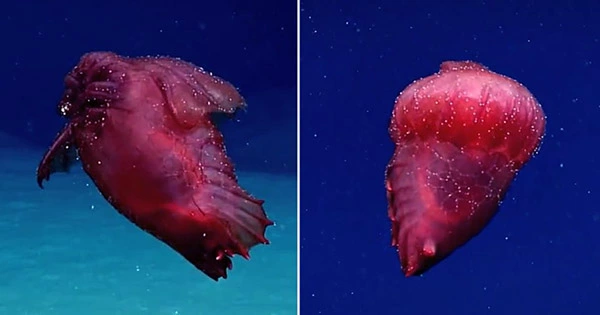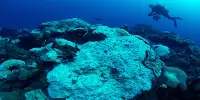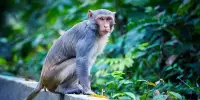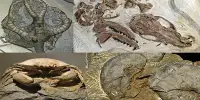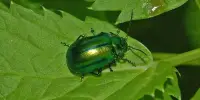When it comes to aquatic species, the headless chicken monster sea cucumber is a bit of a mouthful. Its moniker, Enypniastes eximia, is a homage to its resemblance to beheaded fowl, and it’s popular among remote-operated vehicle (ROV) pilots. Nautilus Live scientists just found one of these headless chickens traveling through the water column. They were looking through the Zeus camera on the ROV Hercules while diving at a depth of almost 2,000 meters at the Loudoun Seamount in the North Pacific Ocean (6,560 feet).
On the footage taken by E/V Nautilus, one researcher can be heard saying, “I’m like trippin’ at the way it swims,” and trippin’ is about right. These sea cucumbers have a one-of-a-kind collection of webbed swimming fin structures that allow them to take to the “air” like a jumbled mass. But it’s an impressive mess. Like other sea cucumbers, headless chicken monsters spend the most of their time on the bottom, where they collect debris from the sands. When threatened by predators, they can ascend to the air, typically discharging excrement along the way to minimize the weight they’re carrying through the water.
They’ll also swim to discover new feeding grounds and to “please science teams,” as Nautilus Live puts it. E. eximia is known as the “swimming sea cucumber” and the “pink see-through fantasia” since it is the sole species in the Enypniastes genus. This species has a striking maroon hue, which one of the commenting experts predicts will be “my new color for the year.”
The E/V Nautilus Expedition to Luuaeaahikiikekumu, which focuses on the ancient seamounts of Liliuokalani Ridge, found the headless chicken monster. Its results expanded on the 2021 Luuaeaahikiikalipolipo trip, which for the first time charted the seamounts. They anticipate that their visual examination of the seamount chain may give fresh insights into “a mysterious bifurcation in the seamount trail,” as they characterize it.
Until then, it appears that the crew is pleased with their finding of a headless chicken monster. “This dark-colored sea cucumber is just one of the spectacular animals we’ve seen while exploring the Liliuokalani Ridge Seamounts on expedition Luuaeaahikiikekumu,” the crew stated.
Sea cucumbers provide an important biological service in the oceans, in addition to pleasing marine biologists. According to research, these “walking colons” excrete the equivalent of five Eiffel Towers per coral reef each year. Their colons are also desirable real estate for certain species, like as pearlfish, who would put up with a deluge of excrement in exchange for a back route. For animals that are essentially living Water Wigglies, this is a rather impressive list of skills.
